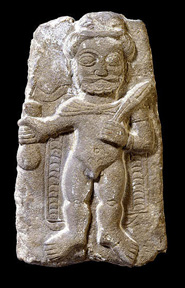
Probably Parthian, late 2nd - early 3rd century CE
From Masjid-i-Suleiman, western Iran
Limestone
Height: 30 cm
Width: 18.2 cm
Acquisition number: #ANE 127335
Gift of Dr. M.Y. Young
Image courtesy of the British Museum (copyright reserved)
Though the Parthian kings sought to establish themselves as the political and cultural heirs of the Achaemenian Empire, during the first two centuries of their rule they were strongly influenced by Greek culture. This sculpture is a good example of how Hellenistic elements were adapted by Iranian craftsmen to help define a new artistic style that was specifically Parthian.
While numerous identities have been suggested (including Athar, the Persian fire god, and even Herakles), an identification of the figure as Hermes, or perhaps a locally interpretation of the Greek god, can be made based upon iconographic evidence. Lines inscribed on the rock by the figure's ankles appear to be in the shape of wings, and he carries a bag and scepter, both attributes of the gods' messenger. Also, in Greek precedents Hermes is frequently depicted the nude beneath his magic cloak, while this figure is similarly garbed.
While the subject matter may be of Greek origin, the image is carved in a manner quite different from Hellenistic prototypes. The body proportions do not reflect those utilized by Greek sculptors, nor is figure's orientation consistent with sculptural friezes carved in the early centuries of the Parthian Empire. Previously, bodies were shown in profile, but in later Parthian art human figures were depicted fully frontal on the frieze. Later both the Sassanian and Byzantines would also adopt this frontal orientation.1
(1) See the British Museum web page dedicated to this object.